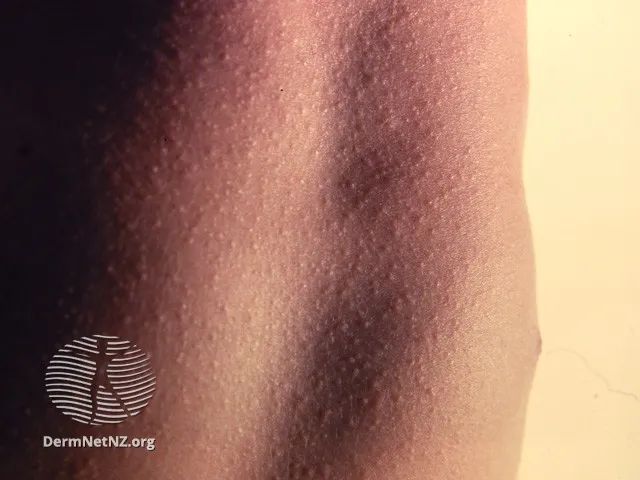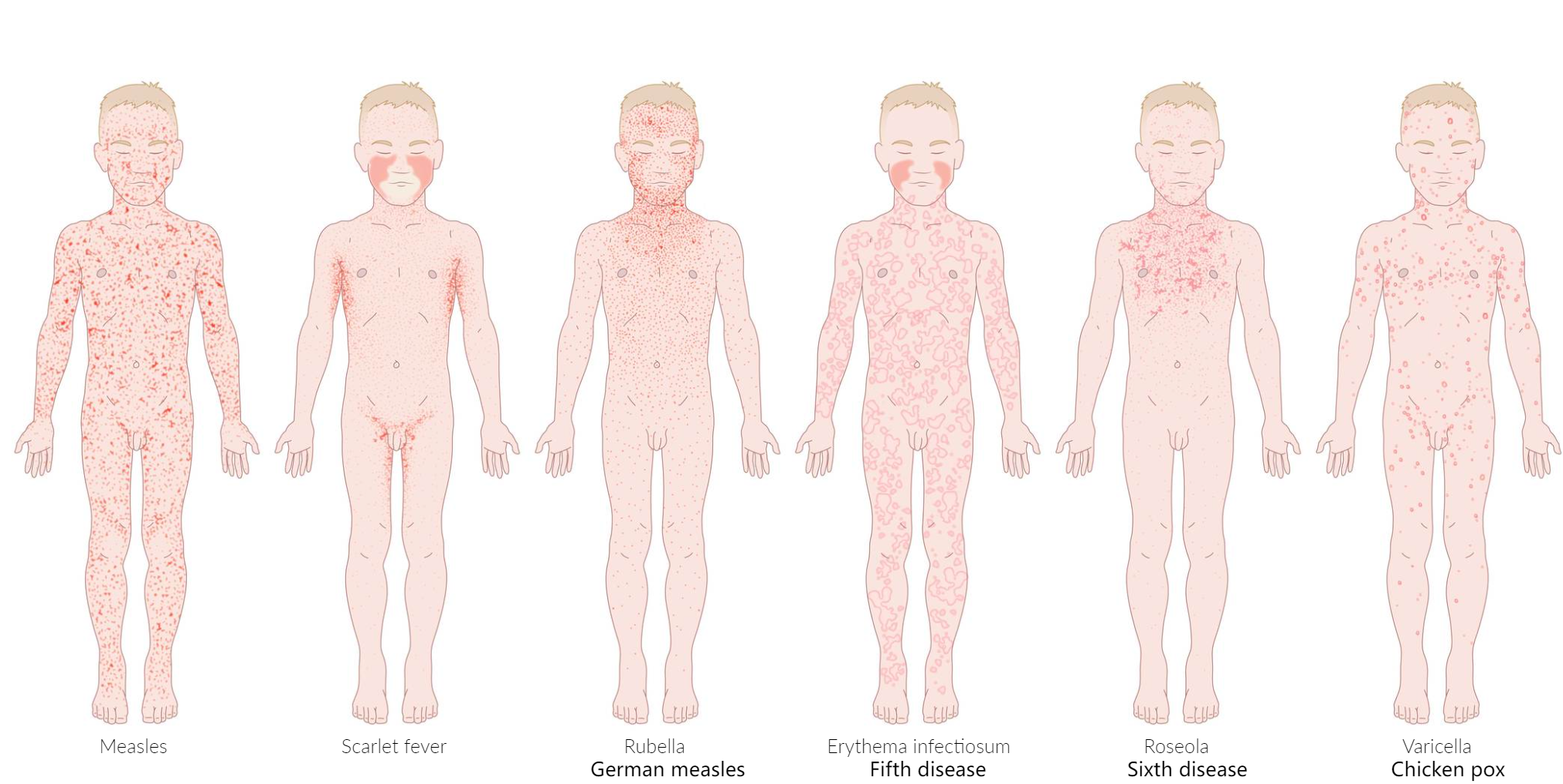Epidemiology
Etiology
- Pathogen
- Group A β‑hemolytic streptococci (Streptococcus pyogenes) produce erythrogenic exotoxin A, B, or C
- These exotoxins cause the rash of scarlet fever via a delayed-type skin reaction.
- Group A β‑hemolytic streptococci (Streptococcus pyogenes) produce erythrogenic exotoxin A, B, or C
- Route of transmission: aerosol
Pathophysiology
Clinical features
Exanthem phase
- Rash manifests 12–48 hours after fever onset.
- Fine, erythematous, sandpaper‑like texture

- Blanches with pressure, but nonblanching petechiae may also be present
- Begins on neck or trunk and spreads rapidly across the body (except for the palms and soles)
- Characteristic features include:
- Flushed cheeks with perioral pallor

- Strawberry tongue: bright red tongue color with papillary hyperplasia, which may initially be covered with a white coating
- Pastia lines
- A characteristic sign of scarlet fever
- Linear, petechial appearance
- Most pronounced in the groin, underarm, and elbow creases (i.e., flexural areas)
- Flushed cheeks with perioral pallor
Diagnostics
| Feature | Scarlet Fever | Acute Rheumatic Fever |
|---|---|---|
| Timing | Concurrent with active GAS infection | Delayed (2–4 weeks post-infection) |
| Pathophysiology | Toxin-mediated (SPEs) | Immune-mediated (molecular mimicry) |
| Rash | ”Sandpaper” texture, diffuse, punctate | Erythema marginatum (serpiginous, clear centers) |
| Key Finding | Strawberry tongue, Pastia’s lines | Migratory polyarthritis, carditis, chorea |
| Treatment Goal | Eradicate active infection, prevent ARF | Reduce inflammation, prevent recurrence with long-term prophylaxis |
Childhood exanthems
Feature Rubella (German Measles) Measles (Rubeola) Scarlet Fever Erythema Infectiosum (Fifth Dis.) Roseola Infantum (Sixth Dis.) Varicella (Chickenpox) Agent Togavirus (RNA) Paramyxovirus (RNA) S. pyogenes (GAS) exotoxin Parvovirus B19 (DNA) HHV-6, HHV-7 (DNA) VZV (HHV-3) (DNA) Prodrome Low-grade fever, postauricular/occipital LAD, arthralgias. 3 C’s: Cough, Coryza, Conjunctivitis. High fever. Fever, pharyngitis, headache, vomiting. Mild flu-like sx. High fever (>40°C) for 3-5 days, child appears well. Fever, malaise. Enanthem Forchheimer spots (petechiae on soft palate) Koplik spots (blue-white spots on buccal mucosa). Pathognomonic. Strawberry tongue, palatal petechiae. N/A Nagayama spots (papules on soft palate). Ulcers in mouth/pharynx. Exanthem Maculopapular rash starts on face, spreads caudally in <24h. Lighter than measles. Maculopapular rash starts at hairline, spreads caudally. Confluent. ”Sandpaper” texture, diffuse erythema. Starts on trunk, spreads out. Spares palms/soles. Circumoral pallor. ”Slapped cheeks” (malar rash), followed by lacy, reticular rash on trunk/extremities. Maculopapular rash appears as fever breaks. Starts on trunk, spreads to face/extremities. Vesicular rash on erythematous base (“dew drop on a rose petal”). Lesions in different stages. Starts on trunk, spreads to face/limbs. Key Buzzwords ”3-day measles”, postauricular LAD. Congenital: PDA, cataracts, deafness. Koplik spots, 3 C’s, SSPE (late complication). Sandpaper rash, strawberry tongue, Pastia’s lines (linear petechiae in flexures). Slapped cheeks, aplastic crisis (in SCD), hydrops fetalis. Fever first, then rash. Febrile seizures common. Pruritic vesicles in crops, Tzanck smear shows multinucleated giant cells. Reactivates as shingles. Tx Supportive. MMR vaccine for prevention. Supportive, Vit A. MMR vaccine for prevention. Penicillin or Amoxicillin (to prevent rheumatic fever). Supportive. Supportive. Supportive. Acyclovir in teens/adults/immunocompromised. Live-attenuated vaccine.
Fever-rash relationship
Link to original
- Measles (Rubeola): Fever first (with cough, coryza, conjunctivitis) → Rash appears 3-5 days later, spreading from head to toe.
- Rubella (German Measles): Low-grade fever → Rash appears 1-2 days later, spreading quickly from head to toe.
- Scarlet Fever: Fever and sore throat begin together → “Sandpaper” rash appears 1-2 days later.
- Erythema Infectiosum (Fifth): Low-grade fever/prodrome resolves → “Slapped cheek” rash appears days later.
- Roseola Infantum (Sixth): High fever for 3-5 days → Fever breaks → Rash appears after the fever is gone.
- Varicella (Chickenpox): Fever and vesicular rash appear at the same time (lesions in various stages).
Treatment
- Initiate one of the recommended antibiotic regimens for acute GAS pharyngitis, e.g.:
- Oral penicillin V or amoxicillin
- Nonsevere penicillin reaction: oral cephalosporins (e.g., cephalexin)
- Severe penicillin reaction: oral macrolides (e.g., azithromycin) or clindamycin
